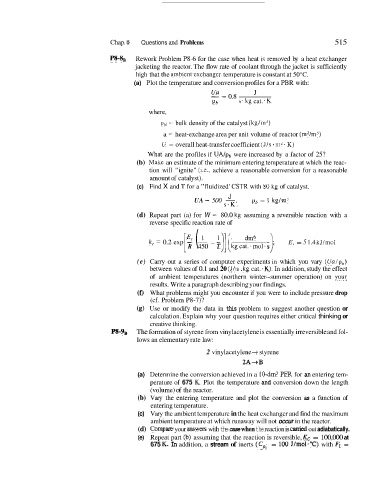Page 545 - Elements of Chemical Reaction Engineering Ebook
P. 545
Chap. 8 Questions and Problems 515
PS-tlB Rework Problem P8-6 for the case when heat is removed by a heat exchanger
jacketing the reactor. The flow rate of coolant through the jacket is sufficiently
high that the ambient.exchanger temperature is constant at 50°C.
(a) Plot the temperature and conversion profiles for a PBR with:
-_ - 0.8 J
Pb s. kg cat. * K
where,
po = bulk density of the catalyst (kg/m3)
a = heat-exchange area per unit volume of reactor (m2/m3)
U = overall heat-transfer coefficient (J/s. m2. K)
"hilt are the profiles if UNpb were increased by a factor of 25?
(b) Make an estimate of the minimum entering temperature at which the reac-
tion will "ignite" (Le., achieve a reasonable conversion for a reasonable
amount of catalyst).
(c) Find X and T for a "fluidized' CSTR with 80 kg of catalyst.
J
UA = 500 - pb = 1 kg/m3
s.K'
(d) Repeat part (a) for W = 80.0 kg assuming a reversible reaction with a
reverse specific reaction rate of
k, = 0.2 exp ( - L)] [
dm6
R 450 T kgcat:mol.s -). ' E, = 5 1.4 kJ/mol
(e) Carry out a series of computer experiments in which you vary (Ualp,)
between values of 0.1 and 20 (J/ s . kg cat. * IC). In addition, study the effect
of ambient temperatures (northern winter--summer operation) on :your
results. Write a paragraph describing your findings.
(f) What problems might you encounter if you were to include pressure drop
(cf. Problem P8-7)?
(g) Use or modify the data in this problem to suggest another question or
calculation. Explain why your question requires either critical thinking or
creative thinking.
P8-9B The formation of styrene from vinylacetylene is essentially irreversible and fol-
lows an elementary rate law:
2 vinylacetylene + styrene
2A+B
(a) Determine the conversion achieved in a 10-dm3 PFR for an entering tem-
perature of 675 K. Plot the temperature and conversion down the length
(volume) of the reactor.
(b) Vary the entering temperature and plot the conversion as a function of
entering temperature.
(c) Vary the ambient temperature in the heat exchanger and find the maximum
ambient temperature at which runaway will not occur in the reactor.
(d) Compare your answets with the case when the reaction is wried out adiabatically.
(e) Repeat part (b) assuming that the reaction is reversible, Kc = 100,000 at
675 K. In addition, a stream of inerts (Cp, = 100 J/mol."C) with It; =

